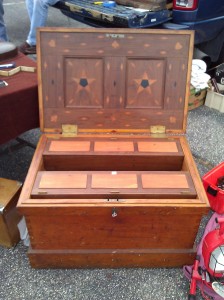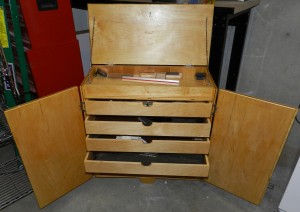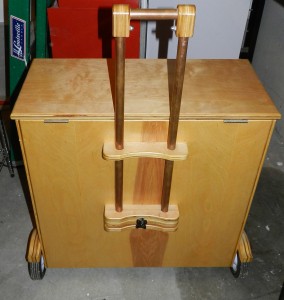We may receive a commission when you use our affiliate links. However, this does not impact our recommendations.
 Bill Rainford, traditional joiner, has been writing guest posts for us this summer. Thanks for all of these amazing woodworking ideas, Bill!
Bill Rainford, traditional joiner, has been writing guest posts for us this summer. Thanks for all of these amazing woodworking ideas, Bill!
Today we are featuring a piece on the principles behind customizing your tool chest, especially the interior.
–Dan
What Does Your Tool Chest Say About You?

Beautiful tool chest from 1849 with extensive inlay work, divided tills and half lock. The maker of this chest clearly must have loved card games.
The spartan exterior of many traditional tool chests was as much a security system as it was a design element. When closed the clean lines and rugged exterior did not draw your attention and looked much the same as many other stoutly built traveling chests and trunks you’d see on a given day. While unassuming in travel or quietly sitting in the back of the shop, many of these chests contained a far more interesting interior.
Beyond just a safe and secure place to store your tools, the way you build and customize your chest says a lot about you and how you work. A clean and orderly chest, worksite, and truck can be a great advertisement for the quality of work you do. I’ve found folks are drawn to a nice chest like moths to a light bulb.
When I built a traveling tool chest for my own work I went with a utilitarian design that functioned much like rolling luggage of today. Inside there is a tray on top, a series of removable drawers to hold planes and small items and some open cubbies that were easily accessible and could be secured behind locking doors. The heavy chest lifts, telescoping handle and wheels make it manageable to move. The drawers can be swapped out depending on the needs of the current project and I can vary the height as needed — having a double-deep drawer, for example.
Tips for laying out the interior of your own chest:
• Design your chest from the inside out to fit your current tools and leave room to grow or modify as your tools and interests change over the years.
• Start with your largest tool — for most it is a No. 7 or No.8 jointer plane or panel saws — and segment from there.
• Tools you use most often should be the easiest to find — marking tools, squares, bench chisels, saws etc.
• Make something you are proud of — you’ll be using this chest for years to come and it will be regularly inspected by all your woodworking friends.
• Don’t be afraid to experiment — the great chests all evolved from earlier models, but temper that by remembering that simplicity and expressed construction will often serve you better than lots of glitz without substance.
The above principles guide me as I build my own tool chests and I hope they will help you to get out into the shop and build a chest that is a reflection of your woodworking skills and personality.
–Bill Rainford
n.b. from Dan:
Bill and I got the idea for this post when I discovered a great article in the Popular Woodworking Magazine archives, on Benjamin Seaton’s famous and highly customized tool chest. It is just one of many interesting pieces in the newly released 1998 complete year download. Check it out, and see what kinds of ideas it gives you for your work!
Here are some supplies and tools we find essential in our everyday work around the shop. We may receive a commission from sales referred by our links; however, we have carefully selected these products for their usefulness and quality.










